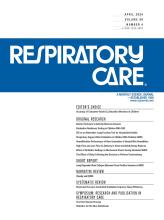Abstract
BACKGROUND: Tracheostomy in patients who are critically ill is generally performed due to prolonged mechanical ventilation and expected extubation failure. However, tracheostomy criteria and ideal timing are poorly defined, including equivocal data from randomized controlled trials and median intubation to tracheostomy times that range from 7–21 d. However, a consistent finding is that only ∼50% of late tracheostomy groups actually undergo tracheostomy, with non-performance due to recovery or clinical deterioration. Unlike in many jurisdictions, elective surgical procedures in our institution require a court-appointed guardian, which necessitates an approximately 1-week delay between the decision to perform tracheostomy and surgery. This offers a unique opportunity to observe patients with potential tracheostomy during a delay between the decision and the performance.
METHODS: ICU patients who were ventilated were identified for inclusion retrospectively by an application for guardianship relating to tracheostomy, the intention-to-treat point. The main outcomes of tracheostomy, extubation, or death/palliative care after inclusion were noted. Demographics, outcomes, and event timing were compared for the 3 outcome groups.
RESULTS: Tracheostomy-related guardianship requests were made for 388 subjects. Of these, 195 (50%) underwent tracheostomy, whereas 127 (33%) were extubated and 66 (17%) either died before tracheostomy (46 [12%]) or were transitioned to palliative care (20 [5%]). The median time (interquartile range) from guardianship request until a defining event was the following: 6.2 (4.0–11) d for tracheostomy, 5.0 (2.9–8.2) d for extubation (P < .001 as compared to tracheostomy group), and 6.5 (2.5–11) d for death/palliative care (P = .55 as compared to tracheostomy). Neurological admissions were more common in the tracheostomy group and less common in the palliative group. Other admission demographics and hospitalization characteristics were similar. Hospital mortality was higher for subjects undergoing tracheostomy (58/195 [30%]) versus extubation (24/127 [19%]) (P = .03).
CONCLUSIONS: Delay in performing tracheostomy due to legal requirements was associated with a 50% decrease in the need for tracheostomy. This suggests that decision-making with regard to ideal tracheostomy timing could be improved, saving unnecessary procedures.
- tracheostomy
- mechanical ventilation
- mortality
- extubation
- prolonged ventilation
- respiratory failure
Footnotes
- Correspondence: Frederic S. Zimmerman MD, Critical Care Unit, Shaare Zedek Medical Center, 12 Shmuel Bayt St. Jerusalem, Israel, 9103102. E-mail: fzimmer{at}szmc.org.il
This study was presented by Drs Zimmerman and Levin at the e-International Symposium on Intensive Care and Emergency Medicine, Virtual Meeting, September 15–18, 2020.
This study was conducted in the Shaare Zedek Medical Center, Jerusalem, Israel.
The authors received no financial support for this article.
The authors have disclosed no conflicts of interest.
- Copyright © 2024 by Daedalus Enterprises
Pay Per Article - You may access this article (from the computer you are currently using) for 1 day for US$30.00
Regain Access - You can regain access to a recent Pay per Article purchase if your access period has not yet expired.







